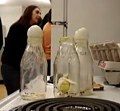UK government vets have confirmed infection with the H5N1 strain of avian influenza in 2600 turkeys that died on a Suffolk farm owned by the Bernard Matthews company. The 159,000 turkey flock will have to be culled with all the risks that entails to prevent the disease spreading further.
According to a statement from the European Commission a protection zone of 3 km radius and a 10 km surveillance zone will be established around Holton, a village about 25 km south-west of Lowestoft.
This is the first time H5N1 has been identified in the UK on a commercial property. A previous outbreak of avian influenza was H7 that required a cull of 50000 fowl to be culled.
There are fifteen known variants of avian influenza. The most virulent, and usually fatal in birds, are H5 and H7 strains. There are then nine variants of the H5 strain and the type of most concern because of the risk to human health is H5N1. While H5N1 can be fatal in humans it has not yet mutated into a form that can be transmitted from person to person.
According to virologist John Oxford of the Queen Mary College, University of London, “I don’t think it has made any difference as a threat to the human population.”
Meanwhile, Channelnewsasia.com today reports yet another outbreak of H5N1 in Japan, the fourth this year.
 “Can visible light ever be manipulated so that it bends the wrong way?” asks Katharine Sanderson in Nature. She suggests that successfully reversing light by making a negative refraction material could open up the possibility of some rather futuristic devices, such as microscope lenses that can resolve objects smaller than the wavelength of light or the much-desired invisibility cloak.
“Can visible light ever be manipulated so that it bends the wrong way?” asks Katharine Sanderson in Nature. She suggests that successfully reversing light by making a negative refraction material could open up the possibility of some rather futuristic devices, such as microscope lenses that can resolve objects smaller than the wavelength of light or the much-desired invisibility cloak. Ever fancied squeezing an egg into a bottle? No? Well, it’s a kind of perennial physics demonstration that science teachers the world over love to do. I could simply describe how to do it and the results you might expect, but that would be no fun at all. Instead, I spent a good ten minutes scanning videos on the net where individuals attempted to carry out this experiment, some of them more successfully than others. Most handling naked flames and solvents (methylated spirits and the like) in a non-laboratory setting with absolutely no safety equipment (not even goggles) in sight.
Ever fancied squeezing an egg into a bottle? No? Well, it’s a kind of perennial physics demonstration that science teachers the world over love to do. I could simply describe how to do it and the results you might expect, but that would be no fun at all. Instead, I spent a good ten minutes scanning videos on the net where individuals attempted to carry out this experiment, some of them more successfully than others. Most handling naked flames and solvents (methylated spirits and the like) in a non-laboratory setting with absolutely no safety equipment (not even goggles) in sight. Bottled seaside air! It almost sounds like a scam from the Victorian era when the bracing “ozone” of fresh air at the British seaside was said to cure all kinds of ailments and led to a boom in seaside resorts and continues to ebb and flow.
Bottled seaside air! It almost sounds like a scam from the Victorian era when the bracing “ozone” of fresh air at the British seaside was said to cure all kinds of ailments and led to a boom in seaside resorts and continues to ebb and flow.